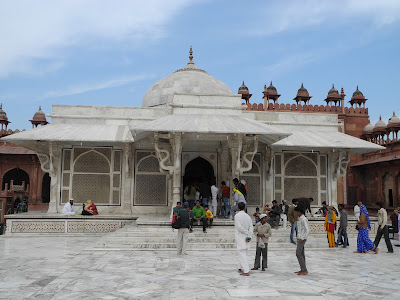Another incredible sight travelling in India: the intricate, precisely carved marble screens forming windows in Mughal (Muslim) architecture.
The Mughal gardens are arranged in the same geometric patterns.
The marble screens at Fatehpur Sikri take the level of skill and intricacy to a whole new level. The palace at Fatehpur Sikri was built by the emperor Akbar, and served as his capital from 1571-1585. Akbar came to this place to seek advice from a wise man, and ask for the birth of a son. When this wish was granted, he returned to build his capital here.
Many buildings are constructed with marble-screened windows facing each other on opposite sides of a room, so that the screens overlap in mosaics of light and dark.
The marble screens are replicated in miniature in this ivory jewellery box, on display in Mumbai's Chhatrapati Shivaji Maharaj Vastu Sangrahalaya Museum (formerly the Prince of Wales Museum), which also appears to be known as the Museum Mumbai. The whole box is only about 20 cm high, and each rhomboid window is perfectly geometric in shape, with only a thin slice of ivory left between the openings.
Tourism India's slogan is "Incredible India," and really, that's the only word to describe much of the country's craftsmanship, architecture and colour.
The Mughal gardens are arranged in the same geometric patterns.
The marble screens at Fatehpur Sikri take the level of skill and intricacy to a whole new level. The palace at Fatehpur Sikri was built by the emperor Akbar, and served as his capital from 1571-1585. Akbar came to this place to seek advice from a wise man, and ask for the birth of a son. When this wish was granted, he returned to build his capital here.
Now this delicately perforated building is visited by childless women
with the same request. The women tie a string onto the marble screen,
and afterward, if they have a child, tradition dictates that they should
return to this place and remove the string.
Many buildings are constructed with marble-screened windows facing each other on opposite sides of a room, so that the screens overlap in mosaics of light and dark.
The marble screens are replicated in miniature in this ivory jewellery box, on display in Mumbai's Chhatrapati Shivaji Maharaj Vastu Sangrahalaya Museum (formerly the Prince of Wales Museum), which also appears to be known as the Museum Mumbai. The whole box is only about 20 cm high, and each rhomboid window is perfectly geometric in shape, with only a thin slice of ivory left between the openings.
Tourism India's slogan is "Incredible India," and really, that's the only word to describe much of the country's craftsmanship, architecture and colour.








The intricacy of design is inspiring Mel. Saw similar style and design in Morocco and in parts of Spain.
ReplyDeleteI agree, Sylvia - it's very inspiring to see the immaculate craftsmanship that has gone into places like these. I also went to the Alhambra in Spain later on this trip and was struck by the similarity of the geometric designs and the level of intricacy. It was interesting to see how the styles varied from region to region, too - the geometric designs of the Alhambra were carved, rather than inlaid, for example. I'm planning to write about the art and architecture I saw in Spain also... eventually!
ReplyDelete